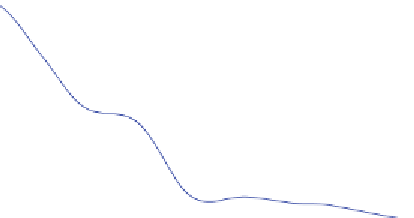Biomedical Engineering Reference
In-Depth Information
TCE
cis
-DCE
VC
Ethene
120
Begin lactic acid injection
100
80
60
40
20
0
0
4
8
12
16
20
24
28
Time (Weeks)
Figure 4.5. Results from a field test measuring biostimulation performance, showing molar
concentrations of TCE and daughter products in groundwater from Cape Canaveral Air Station,
Florida (Facility 1381) (from Morse et al.,
1998
). Lactate was added into the subsurface using two
injection wells, and several monitoring wells within the treatment zone were sampled over time.
The results shown represent the average concentrations from 49 sampling points located within
the treatment zone.
There are several well-monitored field tests that have shown the need for bioaugmentation
and can provide examples of typical dosages and monitoring methods. These demonstrations
include tests at Dover Air Force Base (AFB), Delaware (Ellis et al.,
2000
), Kelly AFB, Texas
(Major et al.,
2002
), and Bachman Road, Minnesota (Lendvay et al.,
2003
). These tests have
used closed-loop active recirculation systems. Such systems allow continuous extraction and
injection of electron donors, improved distribution of the bioaugmentation culture, and
hydraulic isolation of the test plots to some extent. Further, these field tests relied on relatively
dense monitoring networks and frequent sampling intervals, as compared to typical full-scale
remediation designs. Although such active and relatively costly operations may not be needed in
many full-scale remediation projects, this approach is reasonable for field tests of the benefits
of bioaugmentation. The results of these field tests suggest that 3-6 months of operation may
be needed before conclusive results are available.
4.8 HOW VALUABLE IS TIME?
Faster treatment is probably the most common reason for bioaugmenting a site. Bioaug-
mentation can reduce the duration of active treatment, and it also can reduce the lag time before
complete dechlorination is observed. The value of faster treatment can vary tremendously,
depending on several factors. At some sites, or for some responsible parties, time is critical.
Rapid treatment can be important for economic or regulatory reasons, and reaching remediation
objectives as quickly as possible can be far more important than the costs of bioaugmenting,
making it a compelling insurance measure. For example, property transactions or redevelopment
projects can make it extremely important to prevent any delays in the time before active
treatment is over or remedial objectives are met. In such cases, the costs of bioaugmentation
may be minor compared to the costs of several months of suboptimal performance.















































































Search WWH ::

Custom Search